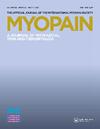Adjunctive Therapy for Myofascial Pain Syndrome
引用次数: 0
Abstract
The lead article for this issue of the Journal of Musculoskeletal Pain [JMP] comes from investigators in Gaziantep, Turkey (1). The authors proposed to evaluate the efficacy of ultrasound [10 sessions] versus extracorporeal shock wave therapies [three sessions] in patients with myofascial pain syndrome [MPS] involving the trapezius muscle on at least one side of the body. They made the diagnosis of MPS according to the criteria of Simons and Travell (2). Their approach involved a controlled clinical trial in which 66 selected MPS patients were randomized to one of two treatment groups. Wisely, patients with comorbid fibromyalgia syndrome [FMS] were excluded. Evaluations were conducted at 3 weeks and 3 months by an examiner blinded to the randomization code. The patients tolerated both of the therapies and there were no severe complications. Statistically significant improvement was observed. Readers are advised to see the authors’ data to determine whether one of these interventions was favored by the experiment and whether the findings of this experiment will inform future choices of a physical modality for treatment of MPS. The second original contribution in this issue, relating to treatment of MPS, comes from Ankara, Turkey (3). This study was designed to determine whether a form of audio biofeedback would augment the treatment of MPS. They made the diagnosis of MPS according to the criteria of Simons and Travell (2). Patients with comorbid FMS were excluded. The authors recruited 90 patients with MPS involving the upper trapezius muscle on at least one side of the body and randomly assigned them into two intervention groups. Sixty of those patients [30 per intervention group] completed the study. The experimental group was instructed to use a portable audio biofeedback device for 30 min twice a day in addition to complying with a home-based exercise program. The control group received only the home-based exercise program. The home-based exercise program included neck isometric-isotonic exercise, back extensor stretching exercise, and posture exercises which were to be accomplished five times a week for 4 weeks, performing 15 repetitions of each exercise once daily. Outcome measurements were taken before starting therapy and after 4 weeks of therapy. The severity of the patient’s pain was measured by a visual analog scale. The number of trigger points, pressure pain threshold, cervical joint range of motion, and head–shoulder angles were recorded. Disability was assessed by the Neck Pain Disability Scale. Statistically significant improvements were observed in this study, including some differences in outcome between the experimental treatment and control groups. Readers are advised to see the authors’ data to determine whether the magnitude of these differences should prompt clinicians to add audio biofeedback to the exercise protocols they order for MPS patients with the objective of achieving specific outcome benefits. An uncontrolled pilot study conducted in Boston, MA, USA has reported the effects of a pain-specific relaxation response resiliency enhancement program [R3P, eight group sessions] for the management of chronic refractory temporomandibular joint disorder of the MPS type, involving the masticatory muscles (4). Twenty-four subjects [16 females], mean age 38 years, with at least a 6-month history of temporomandibular joint disorder completed the study between 2008 and 2010. Eligible participants underwent the R3P intervention after completing a standard medical management program. Preand post-intervention assessments included measures of impairment [vertical and lateral range of motion with and without pain, and temporomandibular joint and muscle pain palpation and algometry measures] and completed psychosocial measures [Symptom Severity Index, Perceived Stress Scale,肌筋膜疼痛综合征的辅助治疗
本期《肌肉骨骼疼痛杂志》(JMP)的主要文章来自土耳其加济安泰普的研究人员(1)。作者建议评估超声[10次]与体外冲击波治疗[3次]对肌筋膜疼痛综合征[MPS]患者的疗效,该综合征至少涉及身体一侧的斜方肌。他们根据Simons和Travell(2)的标准对MPS进行诊断。他们的方法包括一项对照临床试验,其中66名MPS患者被随机分为两个治疗组。明智地,排除了合并纤维肌痛综合征(FMS)的患者。在第3周和第3个月由一名对随机化代码不知情的审查员进行评估。患者对两种疗法均耐受,且无严重并发症。观察到统计学上显著的改善。建议读者查看作者的数据,以确定其中一种干预措施是否受到实验的青睐,以及该实验的发现是否将为未来选择治疗MPS的物理方式提供信息。本期的第二篇原创文章来自土耳其安卡拉,与MPS的治疗有关(3)。本研究旨在确定一种音频生物反馈形式是否会增强MPS的治疗。他们根据Simons和Travell(2)的标准对MPS进行诊断。排除合并FMS的患者。作者招募了90名至少一侧身体上斜方肌的MPS患者,并将他们随机分为两个干预组。其中60名患者(每个干预组30名)完成了研究。实验组被要求使用便携式音频生物反馈设备,每天两次,每次30分钟,此外还要遵守家庭锻炼计划。对照组只接受基于家庭的锻炼计划。以家庭为基础的锻炼项目包括颈部等长等张锻炼、背部伸肌拉伸锻炼和姿势锻炼,每周进行5次,持续4周,每次锻炼每天一次,每次重复15次。在开始治疗前和治疗4周后进行结果测量。用视觉模拟量表测量患者疼痛的严重程度。记录触发点数量、压痛阈值、颈椎关节活动范围和头肩角度。通过颈部疼痛残疾量表评估残疾程度。在本研究中观察到统计学上显著的改善,包括实验治疗组和对照组之间的一些结果差异。建议读者参阅作者的数据,以确定这些差异的大小是否应促使临床医生在MPS患者的运动方案中添加音频生物反馈,以达到特定的结果效益。在美国马萨诸塞州波士顿进行的一项不受控制的试点研究报告了疼痛特异性放松反应弹性增强计划[R3P, 8组会议]对MPS型慢性难治性颞下颌关节疾病的治疗效果,涉及咀嚼肌(4)。24名受试者[16名女性],平均年龄38岁,至少有6个月的颞下颌关节疾病史,于2008年至2010年完成了研究。符合条件的参与者在完成标准医疗管理程序后进行R3P干预。干预前和干预后的评估包括损伤测量[有和没有疼痛的垂直和横向运动范围,颞下颌关节和肌肉疼痛触诊和测量测量]和完成的社会心理测量[症状严重程度指数,感知压力量表,
本文章由计算机程序翻译,如有差异,请以英文原文为准。
求助全文
约1分钟内获得全文
求助全文

 求助内容:
求助内容: 应助结果提醒方式:
应助结果提醒方式:


